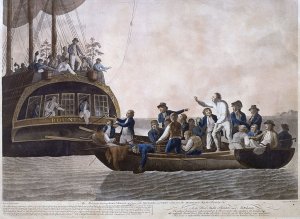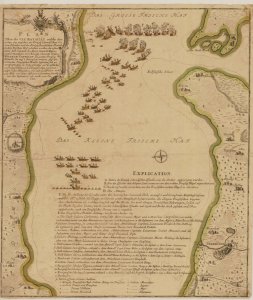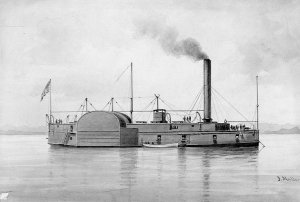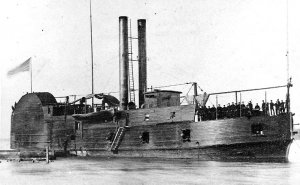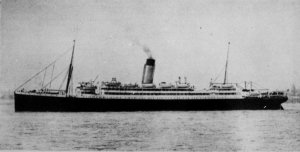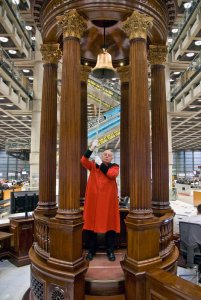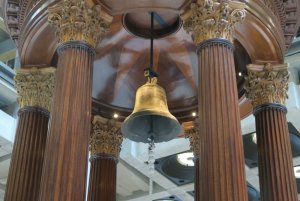Today in Naval History - Naval / Maritime Events in History
24th of August
some of the events you will find here,
please use the following link where you will find more details and all other events of this day .....
1217 – Battle of Sandwich and Death of Eustace the Monk, French pirate
The Battle of Sandwich, also called the Battle of Dover took place on 24 August 1217 as part of the First Barons' War. A Plantagenet English fleet commanded by Hubert de Burgh attacked a Capetian Frencharmada led by Eustace the Monk and Robert of Courtenay off Sandwich, Kent. The English captured the French flagship and most of the supply vessels, forcing the rest of the French fleet to return to Calais.

The Battle of Sandwich, showing the capture of the French flagship and the killing of Eustace the Monk
1499 - spanish navigator Alonso de Ojeda leads the first Europeans arriving with three caravels in the gulf of Venezuela and Lake Maracaibo. He travelled with the pilot and cartographer Juan de la Cosa and the Italian navigator Amerigo Vespucci.
Alonso de Ojeda (Torrejoncillo del Rey, Cuenca-1468 (some sources state 1466) ; Santo Domingo-1515) was a Spanish navigator, governor and conquistador. He travelled through Guyana, Venezuela, Trinidad, Tobago, Curaçao, Aruba and Colombia. He is famous for having named Venezuela, which he explored during his first two expeditions, for having been the first European to visit Guyana, Colombia, and Lake Maracaibo, and later for founding Santa Cruz (La Guairita).
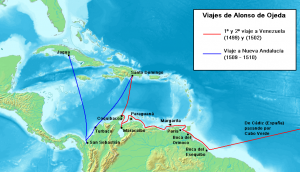
Voyages undertaken by Alonso de Ojeda.
1733 – HMS Warwick 60-gun Completed
HMS Warwick was a 60-gun fourth-rate ship of the line of the Royal Navy, built to the 1719 Establishment at Plymouth by P. Lock. The keel was laid down on 1 April 1730, and the ship was launched on 25 October 1733, and completed on 24 August 1734.

Scale 1:48. Plan showing the body plan, stern board outline, sheer lines with inboard detail, and longitudinal half-breadth for Warwick (1733),
1774 – Launch of HMS Enterprise, a 28 gun Enterprise-class frigate
Remark at beginning:
A very detailed Ship History with all available drawings, History, Models and available kits you can find in our Ship History area of our forum SOS:
https://www.shipsofscale.com/sosfor...74-1807-28-gun-frigate-enterprise-class.1990/
The fifth HMS Enterprise (sometimes spelled Enterprize), 28 guns, was the name ship of a class of twenty-seven sixth-rate frigates of the Royal Navy.

Painting of an fictional model of the HMS Enterprise
1782 – Launch of Censeur a french 74-gun Pégase-class at Rochefort
Censeur was a 74-gun Pégase-class ship of the line of the French Navy, launched in 1782. She served during the last months of the American War of Independence, and survived to see action in the French Revolutionary Wars. She was briefly captured by the British, but was retaken after a few months and taken back into French service as Révolution. She served until 1799, when she was transferred to the Spanish Navy, but was found to be rotten and was broken up.

1786 – Launch of HMS Elephant, a 74 gun Arrogant-class
HMS Elephant was a 74-gun third-rate ship of the line of the Royal Navy. She was built by George Parsons in Bursledon, Hampshire, and launched on 24 August 1786.

1789 - The First Battle of Svensksund
also known as the First Battle of Rochensalm from the Russian version of the Finnish: Ruotsinsalmi, was a naval battle fought in the Gulf of Finland in the Baltic Sea, outside the present-day city of Kotka, on August 24, 1789, during the Russo-Swedish War (1788-1790).

Battle of Svensksund August 24, 1789 by Johan Tietrich Schoult
1798 - HMS Naiad (1797 - 38) and HMS Magnanime (1780 - 44) captured the French frigate Decade (1794/1798 - 36) off Cape Finisterre
HMS Decade was a 36-gun fifth-rate frigate of the Royal Navy. She was formerly the French Galathée-class frigate Décade, which the British had captured in 1798. She served with the British during the French Revolutionary and Napoleonic Wars, and was sold out of the service in 1811.
French service and capture
Décade was built at Bordeaux between March 1794 and January 1795, having been launched on 10 October 1794. She had been previously named Macreuse. After a short career with the French Navy she was captured on 24 August 1798.

A naive drawing depicting the chase and capture of 'Le Decade' by the 'Naiad' on 24 August 1798, off Cape Finisterre (north-west Spain). The 'Naiad', 38 guns, was built by Hall & Co. at Limehouse on the Thames and launched in 1797.
1848 - Ocean Monarch was an emigration barque caught fire at sea and sank with the loss of 178 lives.
The barque was owned by the White Diamond Line and was registered in Boston, the port where she was built. The Ocean Monarch was launched from the East Boston shipyard of Donald McKay in July 1847.

1912 - The collier, USS Jupiter, is launched. The vessel is the first electrically-propelled Navy ship.
USS Langley (CV-1/AV-3) was the United States Navy's first aircraft carrier, converted in 1920 from the collier USS Jupiter (AC-3), and also the US Navy's first turbo-electric-powered ship. Conversion of another collier was planned but canceled when the Washington Naval Treaty required the cancellation of the partially built Lexington-class battlecruisers Lexington and Saratoga, freeing up their hulls for conversion to the aircraft carriers Lexington and Saratoga. Langley was named after Samuel Pierpont Langley, an American aviation pioneer. Following another conversion to a seaplane tender, Langley fought in World War II. On 27 February 1942, she was attacked by nine twin-engine Japanese bombers of the Japanese 21st and 23rd Naval Air Flotillas and so badly damaged that she had to be scuttled by her escorts.

Jupiter 16 October 1913, the collier, before conversion to Langley, the aircraft carrier.

The U.S. Navy aircraft carrier USS Langley (CV-1) underway in June 1927.
1942 – World War II: The Battle of the Eastern Solomons. Japanese aircraft carrier Ryūjō is sunk, with the loss of 7 officers and 113 crewmen. The US carrier USS Enterprise is heavily damaged.
Ryūjō (Japanese: 龍驤 "Prancing Dragon") was a light aircraft carrier built for the Imperial Japanese Navy (IJN) during the early 1930s. Small and lightly built in an attempt to exploit a loophole in the Washington Naval Treaty of 1922, she proved to be top-heavy and only marginally stable and was back in the shipyard for modifications to address those issues within a year of completion. With her stability improved, Ryūjō returned to service and was employed in operations during the Second Sino-Japanese War. During World War II, she provided air support for operations in the Philippines, Malaya, and the Dutch East Indies, where her aircraft participated in the Second Battle of the Java Sea. During the Indian Ocean raid in April 1942, the carrier attacked British merchant shipping with both her guns and her aircraft. Ryūjō next participated in the Battle of the Aleutian Islands in June. She was sunk by American carrier aircraft at the Battle of the Eastern Solomons on 24 August 1942.

Oblique view of Ryūjō at speed, September 1934
24th of August
some of the events you will find here,
please use the following link where you will find more details and all other events of this day .....
Naval/Maritime History - 27th of August - Today in Naval History - Naval / Maritime Events in History
Today in Naval History - Naval / Maritime Events in History 23 August 1890 - USS Baltimore (Cruiser #3) departs New York Harbor to return the remains of inventor John Ericsson to his native Sweden. For the US Navy, Ericssons most notable designs are for USS Princeton and USS Monitor. John...
shipsofscale.com
1217 – Battle of Sandwich and Death of Eustace the Monk, French pirate
The Battle of Sandwich, also called the Battle of Dover took place on 24 August 1217 as part of the First Barons' War. A Plantagenet English fleet commanded by Hubert de Burgh attacked a Capetian Frencharmada led by Eustace the Monk and Robert of Courtenay off Sandwich, Kent. The English captured the French flagship and most of the supply vessels, forcing the rest of the French fleet to return to Calais.
The Battle of Sandwich, showing the capture of the French flagship and the killing of Eustace the Monk
1499 - spanish navigator Alonso de Ojeda leads the first Europeans arriving with three caravels in the gulf of Venezuela and Lake Maracaibo. He travelled with the pilot and cartographer Juan de la Cosa and the Italian navigator Amerigo Vespucci.
Alonso de Ojeda (Torrejoncillo del Rey, Cuenca-1468 (some sources state 1466) ; Santo Domingo-1515) was a Spanish navigator, governor and conquistador. He travelled through Guyana, Venezuela, Trinidad, Tobago, Curaçao, Aruba and Colombia. He is famous for having named Venezuela, which he explored during his first two expeditions, for having been the first European to visit Guyana, Colombia, and Lake Maracaibo, and later for founding Santa Cruz (La Guairita).

Voyages undertaken by Alonso de Ojeda.
1733 – HMS Warwick 60-gun Completed
HMS Warwick was a 60-gun fourth-rate ship of the line of the Royal Navy, built to the 1719 Establishment at Plymouth by P. Lock. The keel was laid down on 1 April 1730, and the ship was launched on 25 October 1733, and completed on 24 August 1734.
Scale 1:48. Plan showing the body plan, stern board outline, sheer lines with inboard detail, and longitudinal half-breadth for Warwick (1733),
1774 – Launch of HMS Enterprise, a 28 gun Enterprise-class frigate
Remark at beginning:
A very detailed Ship History with all available drawings, History, Models and available kits you can find in our Ship History area of our forum SOS:
https://www.shipsofscale.com/sosfor...74-1807-28-gun-frigate-enterprise-class.1990/
The fifth HMS Enterprise (sometimes spelled Enterprize), 28 guns, was the name ship of a class of twenty-seven sixth-rate frigates of the Royal Navy.
Painting of an fictional model of the HMS Enterprise
1782 – Launch of Censeur a french 74-gun Pégase-class at Rochefort
Censeur was a 74-gun Pégase-class ship of the line of the French Navy, launched in 1782. She served during the last months of the American War of Independence, and survived to see action in the French Revolutionary Wars. She was briefly captured by the British, but was retaken after a few months and taken back into French service as Révolution. She served until 1799, when she was transferred to the Spanish Navy, but was found to be rotten and was broken up.
1786 – Launch of HMS Elephant, a 74 gun Arrogant-class
HMS Elephant was a 74-gun third-rate ship of the line of the Royal Navy. She was built by George Parsons in Bursledon, Hampshire, and launched on 24 August 1786.
1789 - The First Battle of Svensksund
also known as the First Battle of Rochensalm from the Russian version of the Finnish: Ruotsinsalmi, was a naval battle fought in the Gulf of Finland in the Baltic Sea, outside the present-day city of Kotka, on August 24, 1789, during the Russo-Swedish War (1788-1790).
Battle of Svensksund August 24, 1789 by Johan Tietrich Schoult
1798 - HMS Naiad (1797 - 38) and HMS Magnanime (1780 - 44) captured the French frigate Decade (1794/1798 - 36) off Cape Finisterre
HMS Decade was a 36-gun fifth-rate frigate of the Royal Navy. She was formerly the French Galathée-class frigate Décade, which the British had captured in 1798. She served with the British during the French Revolutionary and Napoleonic Wars, and was sold out of the service in 1811.
French service and capture
Décade was built at Bordeaux between March 1794 and January 1795, having been launched on 10 October 1794. She had been previously named Macreuse. After a short career with the French Navy she was captured on 24 August 1798.
A naive drawing depicting the chase and capture of 'Le Decade' by the 'Naiad' on 24 August 1798, off Cape Finisterre (north-west Spain). The 'Naiad', 38 guns, was built by Hall & Co. at Limehouse on the Thames and launched in 1797.
1848 - Ocean Monarch was an emigration barque caught fire at sea and sank with the loss of 178 lives.
The barque was owned by the White Diamond Line and was registered in Boston, the port where she was built. The Ocean Monarch was launched from the East Boston shipyard of Donald McKay in July 1847.
1912 - The collier, USS Jupiter, is launched. The vessel is the first electrically-propelled Navy ship.
USS Langley (CV-1/AV-3) was the United States Navy's first aircraft carrier, converted in 1920 from the collier USS Jupiter (AC-3), and also the US Navy's first turbo-electric-powered ship. Conversion of another collier was planned but canceled when the Washington Naval Treaty required the cancellation of the partially built Lexington-class battlecruisers Lexington and Saratoga, freeing up their hulls for conversion to the aircraft carriers Lexington and Saratoga. Langley was named after Samuel Pierpont Langley, an American aviation pioneer. Following another conversion to a seaplane tender, Langley fought in World War II. On 27 February 1942, she was attacked by nine twin-engine Japanese bombers of the Japanese 21st and 23rd Naval Air Flotillas and so badly damaged that she had to be scuttled by her escorts.
Jupiter 16 October 1913, the collier, before conversion to Langley, the aircraft carrier.
The U.S. Navy aircraft carrier USS Langley (CV-1) underway in June 1927.
1942 – World War II: The Battle of the Eastern Solomons. Japanese aircraft carrier Ryūjō is sunk, with the loss of 7 officers and 113 crewmen. The US carrier USS Enterprise is heavily damaged.
Ryūjō (Japanese: 龍驤 "Prancing Dragon") was a light aircraft carrier built for the Imperial Japanese Navy (IJN) during the early 1930s. Small and lightly built in an attempt to exploit a loophole in the Washington Naval Treaty of 1922, she proved to be top-heavy and only marginally stable and was back in the shipyard for modifications to address those issues within a year of completion. With her stability improved, Ryūjō returned to service and was employed in operations during the Second Sino-Japanese War. During World War II, she provided air support for operations in the Philippines, Malaya, and the Dutch East Indies, where her aircraft participated in the Second Battle of the Java Sea. During the Indian Ocean raid in April 1942, the carrier attacked British merchant shipping with both her guns and her aircraft. Ryūjō next participated in the Battle of the Aleutian Islands in June. She was sunk by American carrier aircraft at the Battle of the Eastern Solomons on 24 August 1942.
Oblique view of Ryūjō at speed, September 1934




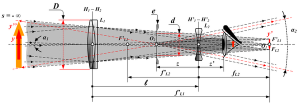
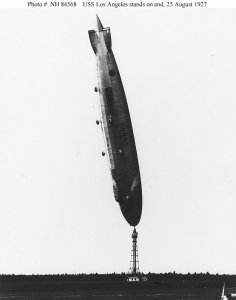
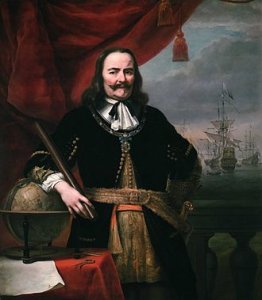
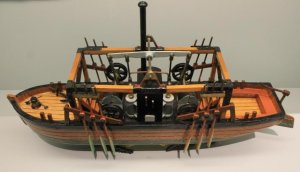
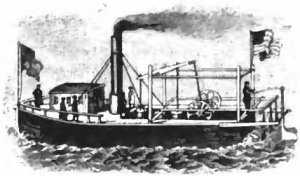
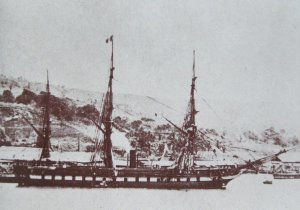
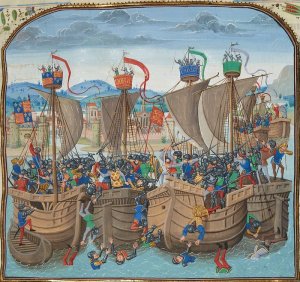


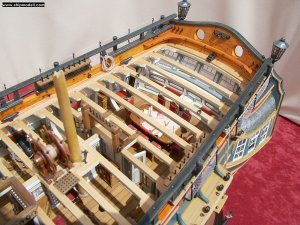
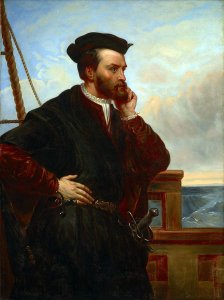
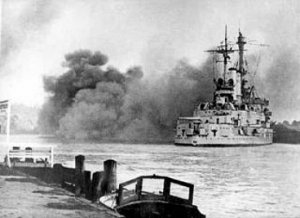

 -Donaldson Line, which later became the Donaldson Atlantic Line. She worked between the
-Donaldson Line, which later became the Donaldson Atlantic Line. She worked between the 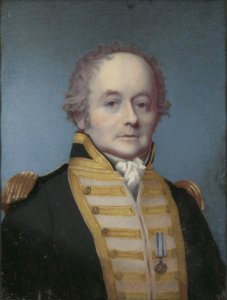
 paper
paper

